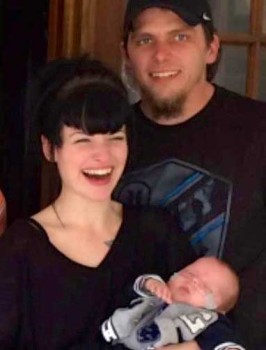
Melissa, Kyle and baby David
Our son David was born three months before his due date because I had a condition known as placenta previa. I went into pre-term labor and with every contraction, David’s heart rate dropped, creating a potentially deadly situation for him. After three days and two nights of this, he was born at 5:30 p.m. on January 28, weighing only 2 pounds, 11 ounces and measuring 15 ¼ inches long.
The scariest aspect of David’s early arrival was the fact that we were marching into the unknown, as David’s dad, Kyle, put it. We didn’t know if he would live or not, whether he would be healthy or have a lot of problems, how long he would have to be in the hospital or how we would cope in the meantime.
Very long days
Kyle had to return to work and I had to focus on my recovery. We made the 90-minute commute to Children’s Wisconsin in Milwaukee every day. Kyle woke up at 5:30 a.m., drove 40 minutes to Fond du Lac where he worked from 6:30 a.m. to 3 p.m., and then (depending on whether I could get a ride to his office) we either drove straight to Milwaukee or he picked me up at home. We spent about three hours each evening with David.
As a mother, it was very difficult only being able to spend a few hours a day with my baby and not being able to bring him home. I cried every night for the first couple weeks at home.
Since David arrived early, his room wasn’t finished, so his stay in the NICU bought us some time (at least on the weekends) to get the majority of his room finished.
Those were very long days. Kyle was very stressed and running on fumes and I was battling post-pregnancy hormones along with a mild case of the baby blues. Most days I didn’t want to get out of bed, but what kept me going was knowing I had to pump milk for my little guy and wanting to see him.
We knew he was in the best hands
We didn’t worry whether he was receiving adequate care because he was in the #1 NICU in the nation, and we saw that the doctors and nurses took their jobs very seriously and loved caring for those tiny patients of theirs. We took comfort in knowing he was in the hands of caring, compassionate experts who were there to save lives, and that’s what we appreciated the most.
We never imagined our little David would be featured in TIME magazine to illustrate the life-saving measures doctors and caregivers take to save these fragile babies.
For Mother’s Day, I organized a brunch at our home. My grandmother from California was visiting, so along with her I invited my mom, grandma, Kyle’s mom, sister, brother-in-law and their son. We don’t have any set plans yet for Father’s Day, but I have a few surprises up my sleeve.







